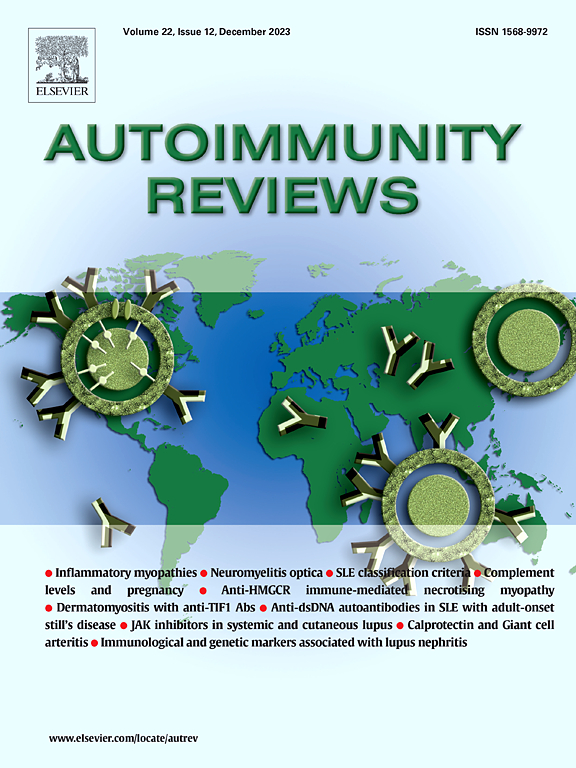Differences in clinical phenotype, laboratory, and imaging manifestations between AQP4 IgG positive and AQP4 MOG IgG double negative NMOSD: How to correctly diagnose the two
IF 9.2
1区 医学
Q1 IMMUNOLOGY
引用次数: 0
Abstract
Neuromyelitis optica spectrum disorders (NMOSD) is an uncommon autoimmune inflammatory demyelinating disorder of the central nervous system (CNS) and causes severe disability and even death. Aquaporin-4 immunoglobulin G (AQP4-IgG) antibody has been confirmed as the key pathogenic factor for development of NMOSD and leading to repeatting acute attacks. However, 20–40 % of NMOSD patients lack both AQP4-IgG and anti-myelin oligodendrocytes glycoproteins (MOG) IgG, in which the pathogenic factor is still unclear. There are differences in clinical, laboretory and imaiging minifestations between AQP4-IgG positive (AQP4-IgG+) and AQP4-IgG/MOG-IgG double negative (AQP4-IgG−) NMOSD. Although the treatments applied in NMOSD have made great progress, all treatments are failed in AQP4-IgG− patients. Additionally, it is hard to identify NMOSD with AQP4-IgG− from multiple sclerosis (MS). Therefore, it is suspected and challenged that AQP4-IgG could not be the only pathogenic factor in NMOSD or NMOSD with AQP4-IgG− may be a separate disorder independent of NMOSD AQP4-IgG+? It is necessary to find more pathogenic factors and to explore the new pathogenesis and treatments of NMOSD with AQP4-IgG− in the future, which has been a serious problem to be addressed by the neurology community.
AQP4 IgG阳性与AQP4 MOG IgG双阴性NMOSD的临床表型、实验室及影像学表现差异:如何正确诊断两者
视神经脊髓炎谱系障碍(NMOSD)是一种罕见的中枢神经系统自身免疫性炎症性脱髓鞘疾病,可导致严重残疾甚至死亡。水通道蛋白-4免疫球蛋白G (Aquaporin-4 immunoglobulin G, AQP4-IgG)抗体已被证实是NMOSD发生并导致反复急性发作的关键致病因素。然而,20- 40% %的NMOSD患者同时缺乏AQP4-IgG和抗髓鞘少突胶质细胞糖蛋白(anti-myelin oligodendrocytes glycoproteins, MOG) IgG,其致病因素尚不清楚。AQP4-IgG阳性(AQP4-IgG+)与AQP4-IgG/MOG-IgG双阴性(AQP4-IgG-) NMOSD在临床、实验室及影像学表现均存在差异。尽管在NMOSD中应用的治疗方法取得了很大进展,但在AQP4-IgG-患者中,所有治疗都失败了。此外,多发性硬化症(MS)的NMOSD与AQP4-IgG-难以鉴别。因此,我们怀疑并质疑AQP4-IgG不可能是NMOSD的唯一致病因素,或者AQP4-IgG-可能是一种独立于NMOSD的单独疾病。今后有必要发现更多的致病因素,探索AQP4-IgG-对NMOSD的新发病机制和治疗方法,这是神经学界亟待解决的问题。
本文章由计算机程序翻译,如有差异,请以英文原文为准。
求助全文
约1分钟内获得全文
求助全文
来源期刊

Autoimmunity reviews
医学-免疫学
CiteScore
24.70
自引率
4.40%
发文量
164
审稿时长
21 days
期刊介绍:
Autoimmunity Reviews is a publication that features up-to-date, structured reviews on various topics in the field of autoimmunity. These reviews are written by renowned experts and include demonstrative illustrations and tables. Each article will have a clear "take-home" message for readers.
The selection of articles is primarily done by the Editors-in-Chief, based on recommendations from the international Editorial Board. The topics covered in the articles span all areas of autoimmunology, aiming to bridge the gap between basic and clinical sciences.
In terms of content, the contributions in basic sciences delve into the pathophysiology and mechanisms of autoimmune disorders, as well as genomics and proteomics. On the other hand, clinical contributions focus on diseases related to autoimmunity, novel therapies, and clinical associations.
Autoimmunity Reviews is internationally recognized, and its articles are indexed and abstracted in prestigious databases such as PubMed/Medline, Science Citation Index Expanded, Biosciences Information Services, and Chemical Abstracts.
 求助内容:
求助内容: 应助结果提醒方式:
应助结果提醒方式:


